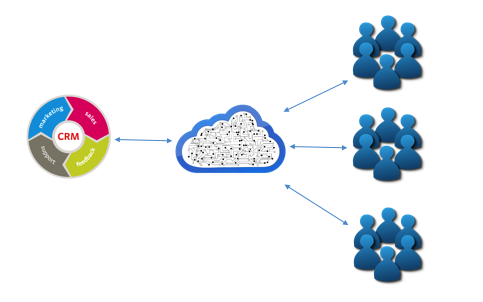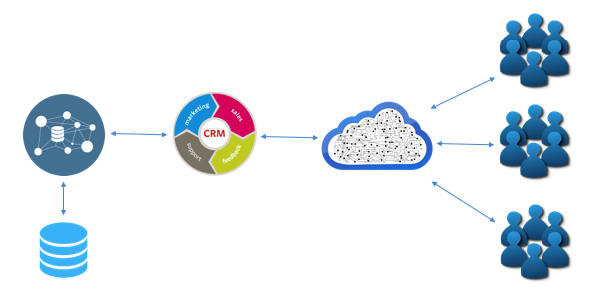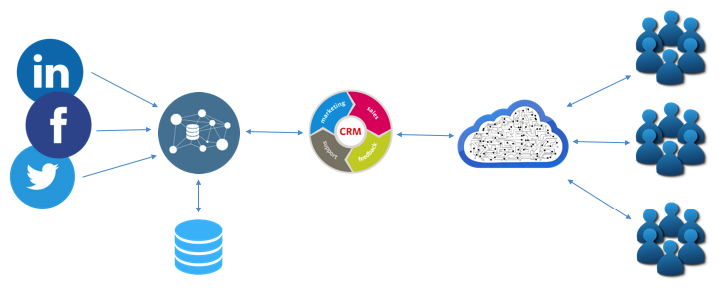Social networks, Big Data, CRM and IoT in your supermarket
How to make your customer’s shopping experience unforgettable
Customer’s decision making has been demonstrated as something not based upon fully rational behavior. There is therefore no optimal solution but only good enough which will lead the consumer. Therefore, we need to create a surrounding in which our customer will feel great and we need to provide him with the relevant information so that we can tailor his shopping experience.
Using Social connectors for capturing data, Big Data for analyzing it, then providing analyzed data to CRM which uses IoT to communicate with the customer, we can create the surrounding and interaction which is optimal for each individual customer, which leads to the customer’s loyalty and to maximizing customer’s value. We shall now take a look at three different scenarios in our fictional supermarket and see how we can use Social Networks, Big Data, CRM and IoT systems to engage our customers.
1. Scenario - CRM and IoT
In this scenario we presume that we are using CRM and IoT devices in our supermarket. We base our interaction with the customer on segmentation.

In this simple scenario in which the customer will have the opportunity to receive a data on a product or to retrieve a list of sources of information or services on a specific product in a supermarket, the consumer will face, potentially, two different situations:
a) There is a few information available or a few services, in that case, the choice will be easy to make, but the added value of the solution will be limited.
b) There are too many information or services available, in that case, the behavior of the consumer will have trouble choosing or even give up.
Also because we are using the segmentation as our basis for the interaction with the customer, product information is not personalized and it is not effective as it can be.
2. Scenario - Big Data, CRM and IoT
In this scenario we presume that we are using Big Data, CRM and IoT devices in our supermarket. We have used Big Data platform to gather and analyze the information on the customer’s buying habits in our supermarket, which we provided as input for customer’s 360 view in CRM and we communicate with him using IoT devices.

In this scenario we can have personalized messages for the customer and a product recommendation which suits his needs. We can achieve cross-sell and upsell. This is a significant step up from the first scenario, but a possible problem with the too much information still remains and it could resolve in our customer having trouble choosing, or even giving up on purchase. Also, we don’t have the optimal information about our customer, so we cannot produce quality behavior analytics.
3. Scenario - Social Networks, BigData, CRM and IoT
As we already established, we do not make decisions based on the facts. We make decisions based on the feelings and if we can achieve that the customer feels great in our supermarket, we have achieved our goal. The first thing that we need to do is to gather the information. In a previous scenario, we have used our “in house” data about the purchases to model our interaction with each customer. We can do predictions from his behavior, but it is not optimal, because the data that we have does not provide us the complete picture. Let’s investigate further this scenario. We have all the information about our customer from our “in house” database and we know he prefers to buy the stakes. When our customer is walking near a meat produce isle, we inform him that we have a discount on stakes and a barbeque sauce, but the information that we did not know was that our customer has chosen a vegetarian lifestyle.
In this scenario our messages have had a negative impact on customer’s shopping experience, but how we were able to know that?
Easy, all the information that were needed for us to communicate the best information to our customer is available on the Social Networks. We can use Social Network connectors to gather the information involving our customers, so that we can achieve the best interaction and also we can tailor buying experience per customer.
In this scenario we could gather the information from the customer’s social network which would inform us about his lifestyle change. Knowing this, we could use Big Data to do the analysis consisting of his own behaviors and the data that we have about the other people who have been doing a similar lifestyle change to communicate the best offer to our customer.

But why to stop there? We can also become familiar with what kind of music and even lightning our customer prefers, so we can tailor the best shopping experience for our customer. With this approach, we have achieved customer loyalty and we can maximize the impact of our interaction which leads to better up-sell and cross-sell, and which consequently, leads to greater customer value.
In my next post we will discuss how we can achieve the third scenario using Oracle products.